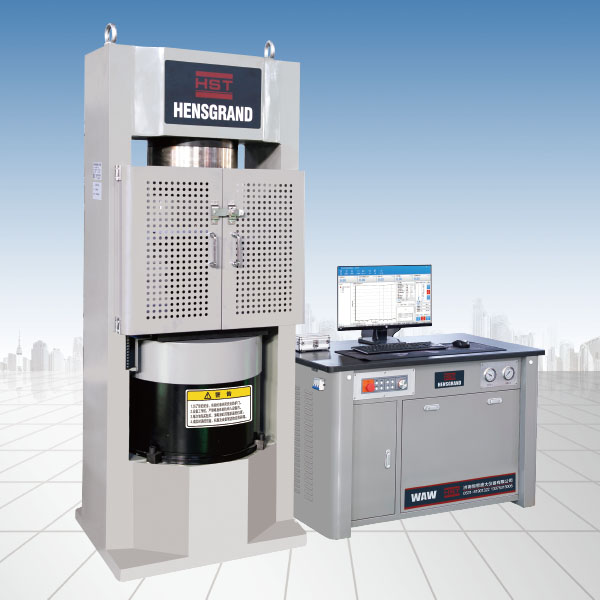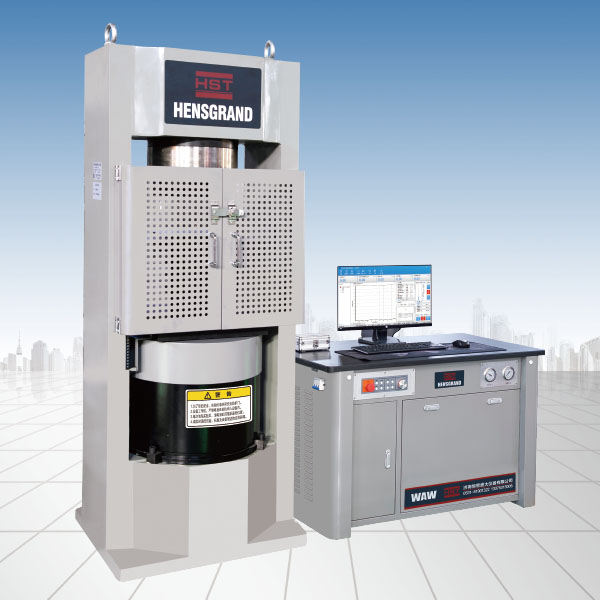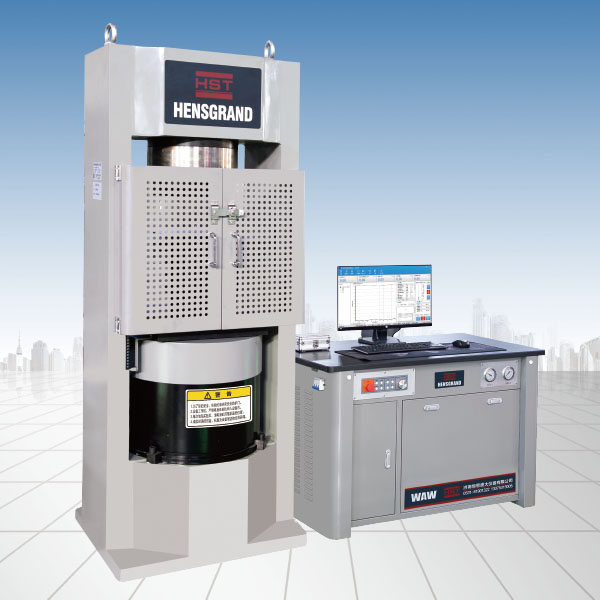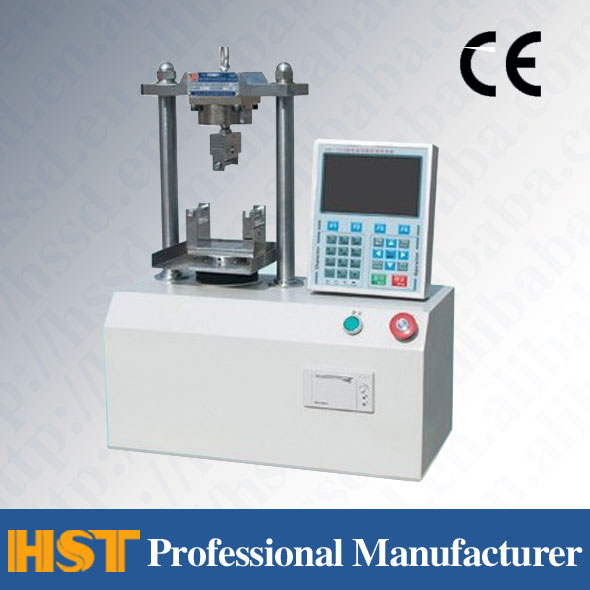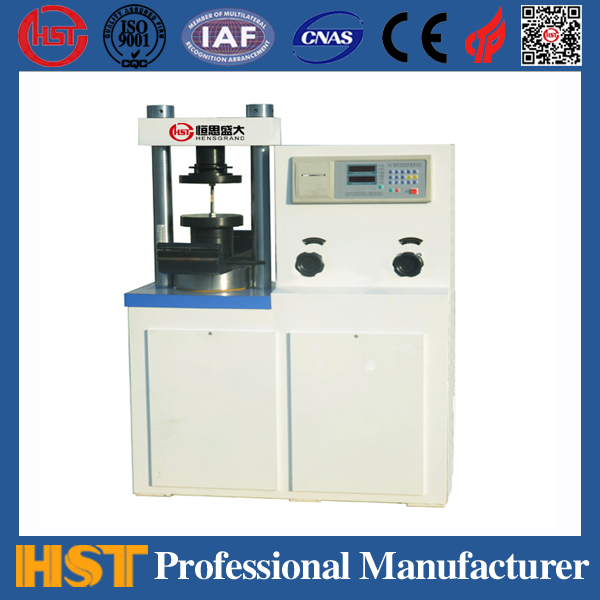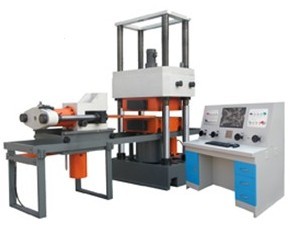Company News
Introduction to the knowledge of electronic universal testing machine
Release time:2018-11-23 source:Jinan Hengsi Shanda Instrument Co., Ltd. Browse:
The yield point is very important in the mechanical properties test of materials. In many cases, its importance is even greater than the ultimate strength value of the material.(Extreme strength is one of the necessary indicators for the mechanical properties of all materials), however, it is not easy to obtain it very accurately in many cases. It is restricted by many factors, summarized as:
1. The influence of fixtures;two,The impact of the testing and control link of the test machine;three,The impact of the result processing software;Four,The influence of the theoretical level of the tester, etc.
1. The influence of fixtures;two,The impact of the testing and control link of the test machine;three,The impact of the result processing software;Four,The influence of the theoretical level of the tester, etc.
one,The impact of fixtures
This type of influence is more likely to occur in the test, mainly manifested as factors such as slippage in the sample clamping part or the large gap between certain force value transmission links of the test machine, and the probability of it appearing on old machines is relatively high. Since the machine will wear after a period of use, the relative moving parts will cause wear, which will significantly reduce the friction coefficient, which is intuitively manifested as the scale peaks of the clamps being smoothed and the friction force is greatly reduced. When the test sample is subjected to a static friction force, the test sample will slip, resulting in false yielding.
This type of influence is more likely to occur in the test, mainly manifested as factors such as slippage in the sample clamping part or the large gap between certain force value transmission links of the test machine, and the probability of it appearing on old machines is relatively high. Since the machine will wear after a period of use, the relative moving parts will cause wear, which will significantly reduce the friction coefficient, which is intuitively manifested as the scale peaks of the clamps being smoothed and the friction force is greatly reduced. When the test sample is subjected to a static friction force, the test sample will slip, resulting in false yielding.
two,The impact of the testing and control link of the test machine
The testing and control link of the test machine is the core of the entire testing machine. With the development of technology, this link has basically adopted various electronic circuits to achieve automatic measurement and control. Due to the profoundness of automatic measurement and control knowledge, complex structure, and opaque principles, once it is not considered in the design of the product, it will have a serious impact on the results and it is difficult to analyze the reasons. The main points for obtaining material yield points are as follows:
1, Sensor amplifier frequency band is too narrowSince the force value detection elements used on the test machine are basically load sensors or pressure sensors, and both types of sensors are analog small signal output types, signal amplification must be performed during use. It is well known that in our environment there are various electromagnetic interference signals that are coupled into the measurement signal through many different channels and are amplified together, resulting in the useful signal being flooded by the interference signal. In order to extract useful signals from interference signals, a low-pass filter is generally provided in the amplifier according to the characteristics of the material testing machine. Reasonably setting the cutoff frequency of the low-pass filter and limiting the amplifier's frequency band to an appropriate range can greatly improve the measurement and control performance of the test machine. However, in reality, people often look at the stable display of data, ignore the authenticity of the data, and set the cutoff frequency of the filter very low. In this way, while fully filtering out the interfering signals, the useful signals are often filtered out. As for universal material testing machines, the author believes that this frequency band should be larger than10HZ,achieve30HZ. In practice, sometimes although the frequency band of an amplifier reaches this range, people often ignore itA/DThe frequency bandwidth of the converter is so that the actual frequency bandwidth is smaller than the set bandwidth. Selected from numerous test machine data acquisition systemsAD7705,AD7703,AD7701etc.2, the data acquisition rate is too lowCurrently, the data acquisition of analog signals is throughA/DConverter to implement.A/DThere are many types of converters, but most of them are used in the test machine.A/DConverter. This type of converter is flexible in use, and the conversion rate can be dynamically adjusted, which can not only achieve high-speed and low-precision conversion, but also achieve low-speed and high-precision conversion. Since the data acquisition rate requirement is not too high on the test machine, it can generally meet the requirements by reaching dozens to hundreds of times per second, so a lower conversion rate is generally used to achieve higher measurement accuracy.3, Improper use of control methodsRelationship between stress and strain when material yields(When yield occurs, the stress remains unchanged or fluctuates up and down, while the strain continues to increase)The national standard recommended control mode is constant strain control, while the elastic stage control mode before yield occurs is constant stress control, which is difficult to complete in most test machines and in a certain test. For using constant displacement control(Speed control)Since the stress rate of the material in the elastic stage is proportional to the strain rate, as long as the appropriate test speed is selected, speed control can be used throughout the process to be compatible with the control characteristic requirements of the two stages. However, for test machines with only one mode of force control, if the test machine responds very quickly(This is what automatic control efforts want to achieve), the process time of yield occurrence will be very short. If the data acquisition speed is not high enough, the yield value will be lost, and excellent control performance will become the cause of errors. Therefore, do not select a single load control mode when selecting the test machine and control method.
three,The impact of the result processing software
Most of the test machines currently produced are equipped with different types of computers(likePCComputers, microcontrollers, etc.)), to complete various data tests that are standard or user-defined. There has been great progress compared to the graphical method widely adopted in the past. However, due to the lag of standards, the original partial definition seems to be unclear enough. For example, the definition of the yield point has only qualitative explanations but no quantitative explanations, which is not suitable for the needs of automatic processing by computers. This causes:
The respective settings of judgment conditionsAs far as surrender is concerned(Stretched with metalGB/T228-2002As an example)The standard defines it like this:Yield of yield: When the metal material shows yield phenomenon, when the stress point where plastic deformation occurs without increasing force during the test, the upper yield strength and the lower yield strength should be distinguished.Up yield strength: The stress before the first drop of the test sample.Lower yield strength: During the yield period, the stress at the initial instantaneous effect is ignored."Questions about yield strength: How to understand "plastic deformation occurs without increasing force(Stay constant)"? Due to the presence of various interference sources, the force value of the material is really constant even during the yield stage(it's out of the question), the data collected by the computer will not remain constant, which requires a allowed data fluctuation range. Since the national standard is not defined, each test machine manufacturer has to define it by itself. Due to the inconsistency of conditions, the results obtained will naturally differ.Questions about the upper and lower yield strength: If the material has an up and down yield point, there will inevitably be up and down fluctuations in the force value, but what is the amplitude of this fluctuation? The national standard has not been explained. If the choice is too small, the interference may be missed as the upper and lower yield points. If the result is too large, some upper and lower yield points may be lost. At present, in order to solve this problem, all manufacturers have thought of many solutions, such as classifying the "Error Band" by materials to define "Error Band""and "volatility amplitude", this can solve most of the usage problems. However, research on unusual materials and new materials still cannot solve the problem. For this purpose, some manufacturers will take "Error belts""and "volatility amplitude"Designed as user-defined parameters, this solves the problem theoretically, but puts high demands on users.Definition of the yield point"Not taking into account the initial instantaneous effect"What is the "initial instantaneous effect""? How did it come about, and did all the experiments exist? The national standards for these issues have not been explained. Therefore, when you find the yield strength, you will lose a "lower peak point" in most cases."of. Since not all test machines have an initial instantaneous effect, you cannot lose all the lower peak points when obtaining the results. But in fact, most manufacturers' test machine processing procedures have lost a peak point.
Four,The impact of the tester
When the test equipment has been determined, the quality of the test results depends entirely on the comprehensive quality of the test personnel. At present, the comprehensive quality of operators of material testing machines in my country is generally not high, and their professional knowledge and theoretical level are generally lacking. In addition, the continuous emergence of new concepts and new terms makes it difficult for them to adapt to the needs of material testing.
The testing and control link of the test machine is the core of the entire testing machine. With the development of technology, this link has basically adopted various electronic circuits to achieve automatic measurement and control. Due to the profoundness of automatic measurement and control knowledge, complex structure, and opaque principles, once it is not considered in the design of the product, it will have a serious impact on the results and it is difficult to analyze the reasons. The main points for obtaining material yield points are as follows:
1, Sensor amplifier frequency band is too narrowSince the force value detection elements used on the test machine are basically load sensors or pressure sensors, and both types of sensors are analog small signal output types, signal amplification must be performed during use. It is well known that in our environment there are various electromagnetic interference signals that are coupled into the measurement signal through many different channels and are amplified together, resulting in the useful signal being flooded by the interference signal. In order to extract useful signals from interference signals, a low-pass filter is generally provided in the amplifier according to the characteristics of the material testing machine. Reasonably setting the cutoff frequency of the low-pass filter and limiting the amplifier's frequency band to an appropriate range can greatly improve the measurement and control performance of the test machine. However, in reality, people often look at the stable display of data, ignore the authenticity of the data, and set the cutoff frequency of the filter very low. In this way, while fully filtering out the interfering signals, the useful signals are often filtered out. As for universal material testing machines, the author believes that this frequency band should be larger than10HZ,achieve30HZ. In practice, sometimes although the frequency band of an amplifier reaches this range, people often ignore itA/DThe frequency bandwidth of the converter is so that the actual frequency bandwidth is smaller than the set bandwidth. Selected from numerous test machine data acquisition systemsAD7705,AD7703,AD7701etc.2, the data acquisition rate is too lowCurrently, the data acquisition of analog signals is throughA/DConverter to implement.A/DThere are many types of converters, but most of them are used in the test machine.A/DConverter. This type of converter is flexible in use, and the conversion rate can be dynamically adjusted, which can not only achieve high-speed and low-precision conversion, but also achieve low-speed and high-precision conversion. Since the data acquisition rate requirement is not too high on the test machine, it can generally meet the requirements by reaching dozens to hundreds of times per second, so a lower conversion rate is generally used to achieve higher measurement accuracy.3, Improper use of control methodsRelationship between stress and strain when material yields(When yield occurs, the stress remains unchanged or fluctuates up and down, while the strain continues to increase)The national standard recommended control mode is constant strain control, while the elastic stage control mode before yield occurs is constant stress control, which is difficult to complete in most test machines and in a certain test. For using constant displacement control(Speed control)Since the stress rate of the material in the elastic stage is proportional to the strain rate, as long as the appropriate test speed is selected, speed control can be used throughout the process to be compatible with the control characteristic requirements of the two stages. However, for test machines with only one mode of force control, if the test machine responds very quickly(This is what automatic control efforts want to achieve), the process time of yield occurrence will be very short. If the data acquisition speed is not high enough, the yield value will be lost, and excellent control performance will become the cause of errors. Therefore, do not select a single load control mode when selecting the test machine and control method.
three,The impact of the result processing software
Most of the test machines currently produced are equipped with different types of computers(likePCComputers, microcontrollers, etc.)), to complete various data tests that are standard or user-defined. There has been great progress compared to the graphical method widely adopted in the past. However, due to the lag of standards, the original partial definition seems to be unclear enough. For example, the definition of the yield point has only qualitative explanations but no quantitative explanations, which is not suitable for the needs of automatic processing by computers. This causes:
The respective settings of judgment conditionsAs far as surrender is concerned(Stretched with metalGB/T228-2002As an example)The standard defines it like this:Yield of yield: When the metal material shows yield phenomenon, when the stress point where plastic deformation occurs without increasing force during the test, the upper yield strength and the lower yield strength should be distinguished.Up yield strength: The stress before the first drop of the test sample.Lower yield strength: During the yield period, the stress at the initial instantaneous effect is ignored."Questions about yield strength: How to understand "plastic deformation occurs without increasing force(Stay constant)"? Due to the presence of various interference sources, the force value of the material is really constant even during the yield stage(it's out of the question), the data collected by the computer will not remain constant, which requires a allowed data fluctuation range. Since the national standard is not defined, each test machine manufacturer has to define it by itself. Due to the inconsistency of conditions, the results obtained will naturally differ.Questions about the upper and lower yield strength: If the material has an up and down yield point, there will inevitably be up and down fluctuations in the force value, but what is the amplitude of this fluctuation? The national standard has not been explained. If the choice is too small, the interference may be missed as the upper and lower yield points. If the result is too large, some upper and lower yield points may be lost. At present, in order to solve this problem, all manufacturers have thought of many solutions, such as classifying the "Error Band" by materials to define "Error Band""and "volatility amplitude", this can solve most of the usage problems. However, research on unusual materials and new materials still cannot solve the problem. For this purpose, some manufacturers will take "Error belts""and "volatility amplitude"Designed as user-defined parameters, this solves the problem theoretically, but puts high demands on users.Definition of the yield point"Not taking into account the initial instantaneous effect"What is the "initial instantaneous effect""? How did it come about, and did all the experiments exist? The national standards for these issues have not been explained. Therefore, when you find the yield strength, you will lose a "lower peak point" in most cases."of. Since not all test machines have an initial instantaneous effect, you cannot lose all the lower peak points when obtaining the results. But in fact, most manufacturers' test machine processing procedures have lost a peak point.
Four,The impact of the tester
When the test equipment has been determined, the quality of the test results depends entirely on the comprehensive quality of the test personnel. At present, the comprehensive quality of operators of material testing machines in my country is generally not high, and their professional knowledge and theoretical level are generally lacking. In addition, the continuous emergence of new concepts and new terms makes it difficult for them to adapt to the needs of material testing.
Recommended productsPRODUCTS


















